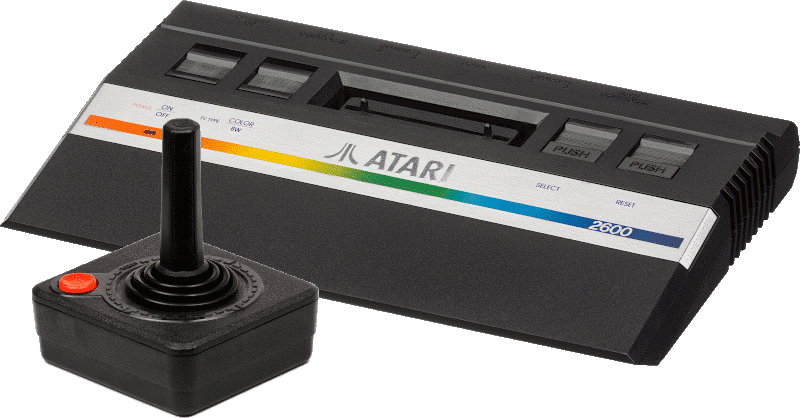

Late Era Atari 2600 Games
1986-1992
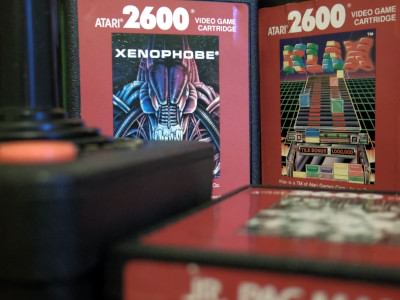 The Atari VCS is known to most people for the heady days of its 1977-1983 heyday. Important though it is, that's not really the era of the console's history that most interests me. Instead, I'm essentially dedicating this corner of my website to reviewing only the games released in the 2600's Indian summer years of post 1986.
The Atari VCS is known to most people for the heady days of its 1977-1983 heyday. Important though it is, that's not really the era of the console's history that most interests me. Instead, I'm essentially dedicating this corner of my website to reviewing only the games released in the 2600's Indian summer years of post 1986.
For reasons beyond me, I've always had a soft spot for cost reduced console redesigns, as well as a fascination for limit pushing games released late in a system's lifespan. The Atari 2600 Jr tickles both of those fancies quite nicely.
But firstly, before we get to the history lesson and the reviews, let me say that the Atari 2600 Jr is a damn fine looking console. With its clean lines, brushed steel fascia and rainbow accent, it bleeds cutting edge mid-80's futurism. It's a truly beautiful piece of industrial design. Old timers might prefer the Wood grain look of the original, but for me this is the Atari 2600 console to own.
Many people don't realise that the task to redesign a cheaper, sleeker looking Atari 2600 began in 1982, with the first production units shipping in 1984, before shortly being shelved by Atari in the wake of Jack Tramiel's takeover of the company. However, Atari later chose to re-release the system in 1986 following Nintendo's revitalisation of the home video game market, with the aim of carving out a niche as a budget competitor to the more advanced and expensive NES and Sega Master System consoles. To do so, Atari likewise re-introduced a choice selection of their vast library of classic arcade titles. While most of these so called "red label" games are simple re-releases, Atari knew such a strategy wouldn't be sustainable in the long run. No, offering consumers an instant library of well known but now quite dated games would not be enough.
To really compete, they would need to program new titles that could offer up game play experiences similar to the increasingly complex games available from new kids on the block Sega and Nintendo. Old frenemies Activision, Absolute Entertainment (itself comprised of ex-Activision staff), Epyx and Salu Ltd. were also called upon to add to the system's late era library. Many of these games are unique and exclusive titles and can be played nowhere else. For the most part, they are also fairly cheap and plentiful to collect, which is a welcome rarity in today's retro gaming climate of infinite price inflation.
As I've noted elsewhere before, here in the UK consoles never really made their presence felt until the early 90's. But I think there's an argument to be made for the Atari 2600 Jr, with its relatively low price point and huge library, to be considered among the first consoles to properly challenge the stranglehold home computers had over the games industry here. The system's simpler games appealed particularly to younger kids just getting into gaming in the late 80's. Evidently, Atari must have been doing something right, because the console would remain in production until 1992! (the same year the Super Nintendo arrived on our shores! Not too bad for tech dating back to the 70's). Some shops were still selling the console for £31.99 as late as 1993. That's almost the same price as a single Sega Master System game.
As for my own history with the Atari 2600 Jr, I often played this console at a friends house. He eventually sold it to buy a Sega Master System and it would be years before I would buy a 2600 console of my own. Despite this, I did actually grow up playing a lot of Atari 2600 games. I had a TV Boy, a cheap pirated clone console with 127 built in games (but that's a review for another day).
Did Atari and their allies succeed in keeping the 2600 relevant? Read on to find out...
32 in 1 (1988)
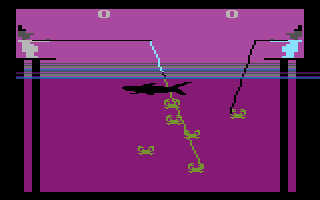 Our first game isn't really a new game at all, but rather a compilation of 32 earlier titles (mostly from Atari and Activision). Here in PAL territories, this was the pack-in game shipped with all new Atari 2600 consoles from about 1988 onwards. Like most game compilations, there's a fair amount of dead weight here (Fun with Numbers, Flag Capture, Black Jack) and even some cheeky sprite-hacked duplicates. But there are plenty of classics here, too (Stampede, Skiing). There's something slightly fishy about this compilation, however. Many Activision titles lack their typical onscreen copyright acknowledgements and most are clearly NTSC ROMs because they display incorrect colours on my PAL 2600 (the grass in Stampede appears blue!). The games list is also suspiciously similar to a few pirate multi-carts that I've seen for sale on ebay. Could it be that Atari enlisted the help of pirates to manufacture these cartridges? Who could say for certain..?
Our first game isn't really a new game at all, but rather a compilation of 32 earlier titles (mostly from Atari and Activision). Here in PAL territories, this was the pack-in game shipped with all new Atari 2600 consoles from about 1988 onwards. Like most game compilations, there's a fair amount of dead weight here (Fun with Numbers, Flag Capture, Black Jack) and even some cheeky sprite-hacked duplicates. But there are plenty of classics here, too (Stampede, Skiing). There's something slightly fishy about this compilation, however. Many Activision titles lack their typical onscreen copyright acknowledgements and most are clearly NTSC ROMs because they display incorrect colours on my PAL 2600 (the grass in Stampede appears blue!). The games list is also suspiciously similar to a few pirate multi-carts that I've seen for sale on ebay. Could it be that Atari enlisted the help of pirates to manufacture these cartridges? Who could say for certain..?
With single player AI levels ranging anywhere between a brain damaged mollusc and a faultless machine god, you'll get the most out of these games if you can find an actual flesh and blood human to play with. Tennis, Boxing, Fishing Derby (pictured) and Combat really come alive in competitive play and I have fond memories of playing these games with my best friend after school. It's worth picking up for the Activision titles alone, but it's nice to have an instant collection of earlier Atari titles too, if only to see how far video games have progressed since 1977.
Midnight Magic (1987)
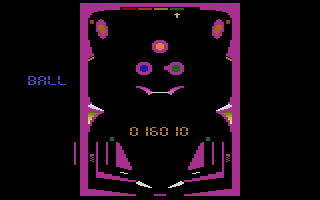 Midnight Magic is supposedly a conversion of the Broderbund computer game of the same name, yet it hardly resembles any of its home computer predecessors. Instead, it features a redesigned table unique to this version of the game.
Midnight Magic is supposedly a conversion of the Broderbund computer game of the same name, yet it hardly resembles any of its home computer predecessors. Instead, it features a redesigned table unique to this version of the game.
Visuals are very impressive, with a stylish high-res look that defies expectations of the system's typical blocky graphics. Screenshots honestly don't do the game justice. Action plays out over a single screen only, although there are still plenty of targets and score multipliers to aim for. Game play is likewise very simple; pull back on the joystick and hit the fire button to launch a ball, left and right on the joystick triggers each set of flippers (or hit down on the joystick to trigger both sets at the same time).
I've heard it said that pinball games live or die by their ball physics and while I can't claim to be an expert, even I can tell this is no "realistic" simulation game. But I do think they're probably as good as could be expected from such modest hardware. The game certainly puts earlier primitive efforts like Video Pinball (1980) to shame. With it's multi-screen table, more realistic physics and nicer looking graphics, Nintendo's 1984 Pinball game might be considered a "better" game, but I think Midnight Magic is more fun. It's also one of my favourite games for the Atari. Recommended.
Jr Pac-Man (1987)
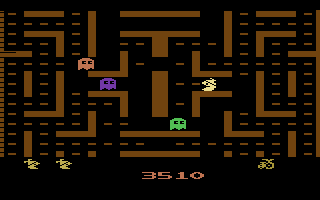 Jr. Pac-Man is one of the more obscure entries in the long running Pac-man series. The unauthorised product of a licensing deal between Namco and Bally Midway that ultimately went sour, the more cynical among us might view Jr. Pac-man as another weak attempt to squeeze every last drop of profit from the lucrative Pac-man brand. And perhaps they're right.
Jr. Pac-Man is one of the more obscure entries in the long running Pac-man series. The unauthorised product of a licensing deal between Namco and Bally Midway that ultimately went sour, the more cynical among us might view Jr. Pac-man as another weak attempt to squeeze every last drop of profit from the lucrative Pac-man brand. And perhaps they're right.
But here on the Atari 2600, Jr. Pac-man is the best entry in the series. It's everything the original Pac-man should have been. It's also extremely difficult. The action is fast and furious and the ghosts are highly aggressive. Each vertically scrolling maze is huge and completely enclosed, meaning there are no handy warp tunnels to escape through when the ghosts close in for the kill. All of this makes for some very tense and challenging game play. So challenging in fact, I can barely make to the second maze! There's nothing ground breaking here, just a solid arcade experience. If you'd like to add a Pac-man game to your collection, make it this one.
Solaris (1986)
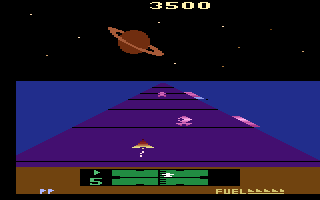 Solaris is something a little bit special. And you're going to need to RTFM for this one, because it's one of the most complex titles ever made for the system. Too complicated to fully explain in such a short review, but it's basically a space shooter in which you must warp around a vast star map (16 quadrants containing 48 sectors), attacking Zylon planets and defending allied planets, all while keeping a careful eye on your fuel supply. The ultimate goal is to find the illusive planet Solaris and rescue the stranded colonists.
Solaris is something a little bit special. And you're going to need to RTFM for this one, because it's one of the most complex titles ever made for the system. Too complicated to fully explain in such a short review, but it's basically a space shooter in which you must warp around a vast star map (16 quadrants containing 48 sectors), attacking Zylon planets and defending allied planets, all while keeping a careful eye on your fuel supply. The ultimate goal is to find the illusive planet Solaris and rescue the stranded colonists.
This is easily one of the best looking and most accomplished games for the console. The graphics are simply stunning, with plenty of trippy visual effects for your eyes to feast on. Once again, static screenshots don't do the game justice. A fairly common and cheap game, Solaris is well worth picking up if you want to see what the 2600 can really do in a capable programmer's hands. Originally intended to be a tie-in with The Last Starfighter, Solaris ultimately became something of a sequel to one of Doug Neubauer's earlier games, the equally complicated and technically impressive FPS space combat sim "Star Raiders" (ported to the 2600 by Carla Meninsky).
Xenophobe (1990)
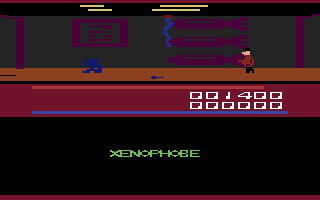 Very clearly "inspired" by the Alien franchise, Xenophobe is a port of the run and gun arcade game from Bally Midway. Yes, you read that correctly. A run and gun game on the humble 2600! I couldn't believe it. The premise is fairly standard: You must clear out a hostile alien invasion force from a space station before the time limit runs out. Action takes place over multiple screens, with plenty of tentacles, knock off face-huggers and Xenomorphs to blast away with a host of lethal weapons. Impressive stuff indeed.
Very clearly "inspired" by the Alien franchise, Xenophobe is a port of the run and gun arcade game from Bally Midway. Yes, you read that correctly. A run and gun game on the humble 2600! I couldn't believe it. The premise is fairly standard: You must clear out a hostile alien invasion force from a space station before the time limit runs out. Action takes place over multiple screens, with plenty of tentacles, knock off face-huggers and Xenomorphs to blast away with a host of lethal weapons. Impressive stuff indeed.
I really wanted to like Xenophobe but sadly, it feels like a bridge too far the ancient console. The Lego brick graphics are frankly ugly, even for the 2600, and the controls don't feel quite as fluid as they should (your experience will be improved if you play with a CX78 joypad or a more widely available Mega Drive controller, however). But then again, perhaps I've just been spoiled because I grew up playing the excellent Alien 3 on the Sega Master System. They almost nailed it. Almost. But regardless of your opinion, you can't fault the ambition on show here.
Kung-Fu Master (1987)
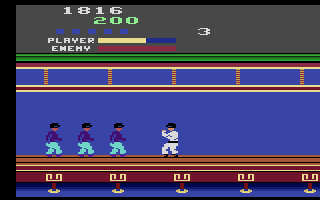 Irem's seminal single plane beat-em-up Kung-Fu Master (A.K.A Spartan X) is perhaps best remembered as an early "black box" launch title for the north American release of the Nintendo Entertainment System way back in 1985.
Irem's seminal single plane beat-em-up Kung-Fu Master (A.K.A Spartan X) is perhaps best remembered as an early "black box" launch title for the north American release of the Nintendo Entertainment System way back in 1985.
But how does the 1987 Activision port for the humble Atari 2600 stack up against the competition? I'm happy to report that it's almost as good as Nintendo's classic effort. As to be expected from a pioneer of the genre, Kung Fu is a rather basic affair. Make you way up a Game of Death style Pagoda by moving to the right (or the left), punching, kicking or avoiding bad guys as you go until you reach and defeat an end of level boss. But don't stand still even for a moment... Enemies are infinite and relentless. No, it's not terribly involved. None of these games are. But like all fun arcade-style games, it satisfies the simple urge to break a few pixelated faces in between more pressing responsibilities.
Aside from sprite limitations and an obvious graphical downgrade, this is a solid good looking port which manages to include almost everything from the arcade original. Your boi Thomas still scoots along like he shat himself, but most of the enemy and boss characters are present and there's even a catchy little tune playing along with the action that sounds not dissimilar to the NES rendition (if you're familiar with the usual atonal horror of standard Atari "music", you'll know this is a pretty big deal). All that's really missing here is the ability to nut punch the bad guys so hard they fly off the building (thanks to hardware limitations, in this version they simply disappear).
No, it's not the most advanced Arcade/NES game ever, but it's still impressive to see Activision get so close to replicating the experience on much inferior hardware. It's a little tricky to play with a joystick however, so use an Atari compatible control pad if you have one (P.S. Kung Fu also happens to be one of my favourite NES games).
RealSport Boxing (1988)
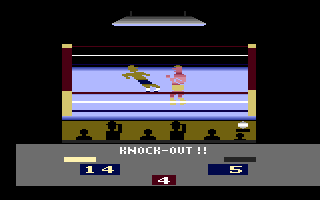 First impressions of RealSport Boxing are pretty good. The graphics are up there with the best on offer among sports games for the 2600, representing the sport of boxing brilliantly considering the hardware. There's the ring and our pugilists of course (both looking great), but perhaps more surprisingly is an enthusiastic animated crowd sat at ringside! Bet you never expected to see that in an Atari game!
First impressions of RealSport Boxing are pretty good. The graphics are up there with the best on offer among sports games for the 2600, representing the sport of boxing brilliantly considering the hardware. There's the ring and our pugilists of course (both looking great), but perhaps more surprisingly is an enthusiastic animated crowd sat at ringside! Bet you never expected to see that in an Atari game!
There are four boxers for players to choose from in all, and each brawler has their own distinctive (albeit rather blocky) appearance. Each competitor also has their own unique weakness to exploit. Keep landing punches to power up a strength meter. When the status bar begins to flash, your boxer is ready to deliver a knock out blow. Pretty advanced for the ol' VCS. Not that any of it matters. Because even on the toughest difficulty setting, computer-controlled boxers are trivially easy to knock out cold. Simply stand toe-to-toe, begin button mashing furiously and in record time, these lightweights will hit the mat like a sack of spuds. I've never had a fight go the distance.
If you can find a real flesh and blood opponent, there may be some fun to be had pummeling the snot out of one another, but I'm sad to say that in single player mode the game becomes almost immediately stale. Stick to Activision's Boxing. It lacks the good looks on offer here, but at least it manages to put up a decent fight. Nothing dates quite as badly as a sports title and this is one for collectors only.
Sprint Master (1988)
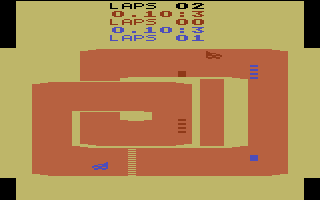 Sprint Master is essentially Super Sprint for your Atari 2600. For some reason it's not called that, but that's exactly what it is. It's not a bad little conversion, either. With 9 tracks of varying difficulty on which to test your driving skills and 3 alternate surfaces (blacktop, dirt and ice), there are an impressive number of options on offer here to increase replayablity. If you're insane, you could even race for 50 laps!
Sprint Master is essentially Super Sprint for your Atari 2600. For some reason it's not called that, but that's exactly what it is. It's not a bad little conversion, either. With 9 tracks of varying difficulty on which to test your driving skills and 3 alternate surfaces (blacktop, dirt and ice), there are an impressive number of options on offer here to increase replayablity. If you're insane, you could even race for 50 laps!
Unfortunately, the weak point of the game is the opposing racer's lackluster A.I. He'll trundle leisurely along, never deviating from his pre-programmed course, while you speed ahead leaving him in the dust. Or so you will once you become accustomed to the tricky handling of your race car (I'm sure a misspent youth playing Micro Machines helped me out here). But when you do, there's not much challenge remaining except to best your own lap times.
Maybe it's unfair to compare Sprint Master to later titles like Super Off Road and Micro Machines, but at least those games brought a healthy dose of chaos and unpredictability to the mix. That's the ingredient really missing here. With all that said, I can imagine this being a fairly enjoyable two player racing game back in the day.
Skate Boardin' (1987)
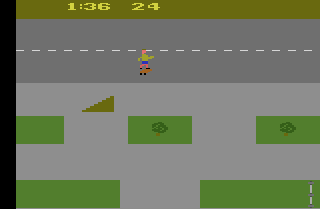 I miss my skateboard. It had bright neon yellow wheels and a skull and crossbones design. It was peak early 90's cool. My sister's was arguably even better; neon pink and blue with an angry looking shark design. But alas, the year is 2021 and I'm more gnarled than gnarly these days. I'm not a dog, a teenager or an ageing pro-skater, so frankly I shouldn't be caught dead anywhere near a skateboard at my age. But don't be thinking you can stop this righteous dude from catching some radical air and living the California dream in Absolute Software's Skateboardin'.
I miss my skateboard. It had bright neon yellow wheels and a skull and crossbones design. It was peak early 90's cool. My sister's was arguably even better; neon pink and blue with an angry looking shark design. But alas, the year is 2021 and I'm more gnarled than gnarly these days. I'm not a dog, a teenager or an ageing pro-skater, so frankly I shouldn't be caught dead anywhere near a skateboard at my age. But don't be thinking you can stop this righteous dude from catching some radical air and living the California dream in Absolute Software's Skateboardin'.
The premise of Skateboardin' is very simple. Your skater has 5 minutes to find and clear 30 ramps and tubes before returning to school on time. To hinder your progress, there are plenty of hazards to knock you off your board and grassy patches to slow you down. You can even skitch a ride on a car or too (but there are no good reasons for doing so that I can tell).
Controls take some getting used to, but are fairly solid and responsive. While skating, a cheerful and extremely catchy melody plays along in the background. In all seriousness, this fantastic little chiptune might be the best peice of music ever heard in a commercial 2600 game. As you roam freely around the game's impressively large map, it quickly becomes apparent that exploration is where the challenge of this game really lies. It should take you a decent amount of time to memorise the best routes between each hidden pipe and ramp. The more ramps and tubes you clear, the better your final rating (listed in the instruction booklet). Clear them all and you may consider yourself "totally awesome".
Make no mistake, this early skateboard 'em up is no embryonic Tony Hawk game. I also wish the ramp and tube locations could be randomised to add some extra replay value, because beyond successfully clearing all 30 obstacles in the quickest possible time (which is no easy feat!), there isn't a great deal to Skateboardin' to keep you playing for long. But there is a certain charm and appeal to the game that I can't really put into words. It's just inherently likeable to me. Is it a good game? Do I think you should play it? I don't know. But I can say there's nothing else quite like it in the 2600 library and I salute David Crane for trying something a little bit different here.
Desert Falcon (1987)
 I have to be honest here, I'm not a huge fan of isometic shoot 'em ups. Even when well-executed, they add an unwelcome layer of extra frustration to a genre that already requires intense concentration and pixel perfect reflexes. And so it goes with Desert Falcon.
I have to be honest here, I'm not a huge fan of isometic shoot 'em ups. Even when well-executed, they add an unwelcome layer of extra frustration to a genre that already requires intense concentration and pixel perfect reflexes. And so it goes with Desert Falcon.
Firstly, the good stuff. Scrolling is very smooth and the eponymous Desert Falcon sprite is very well animated, even casting an animated shadow to help you gauge your height. Desert Falcon also includes game play elements you'd never expect to see in a 2600 title. There are a surprisingly large and varied number of Power-ups on offer, gained by collecting differing combinations of hieroglyphs littered amongst the treasures (your falcon must land to collect these), a bonus round and even an end of level boss! (a Sphinx that you must shoot in the face to defeat). Each game begins with a musically decent Middle Eastern inspired jingle, but sadly this quickly gives way to an insipid Jaws-esque theme and the usual crunchy Atari sound effects.
Despite the impressive feats of programming and ambition on show here, they only serve to highlight the technological chasm between the 2600 and its next generation competitors. Compare Atari's 2600 and 7800 versions of Desert Falcon and you'll see what I mean. Thanks to the small play area, the game's just too difficult to be much fun at higher difficulty levels. Enemies and flying Sphinx darts materialise near instantly on screen and can often be impossible to avoid. Then again, perhaps I'm simply rubbish at the game.
It's not a bad game by 2600 standards. The unique premise and setting sets it apart from other shmups on the system and is just enough to keep me coming back for more. While Desert Falcon doesn't deserve the scorn it receives from some quarters, it's still rather difficult to recommend. As a fairly common and cheaply found title on the second hand market however, it may be worth a look to curiosity seekers.
Klax (1990)
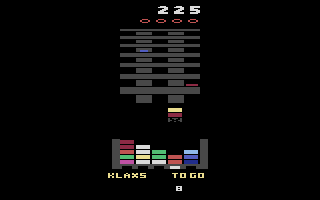 Nintendo had Tetris for their Game Boy, Sega had Columns for their Game Gear, it seemed like every handheld console needed an obligatory puzzle game back in the early 1990's and the Atari Lynx was no exception with Klax. Originally programmed to be a follow up to their Tetris Coin-Op, Klax is a simple tile matching action puzzler. Coloured tiles fall down a conveyor belt and must be stacked by the player at the bottom of the screen. Stack three or more blocks of the same colour vertically, horizontally or diagonally to make them disappear to score points. Occasionally a flashing block will be dropped and can be used to match with any colour. It's also possible to combo multiple lines or "Klaxes" to score more points. Drop too many tiles or allow the playing area to completely fill up and it's game over.
Nintendo had Tetris for their Game Boy, Sega had Columns for their Game Gear, it seemed like every handheld console needed an obligatory puzzle game back in the early 1990's and the Atari Lynx was no exception with Klax. Originally programmed to be a follow up to their Tetris Coin-Op, Klax is a simple tile matching action puzzler. Coloured tiles fall down a conveyor belt and must be stacked by the player at the bottom of the screen. Stack three or more blocks of the same colour vertically, horizontally or diagonally to make them disappear to score points. Occasionally a flashing block will be dropped and can be used to match with any colour. It's also possible to combo multiple lines or "Klaxes" to score more points. Drop too many tiles or allow the playing area to completely fill up and it's game over.
Is it any good? Well, it's decent enough, but it's certainly no Tetris. For whatever reason, it doesn't quite hold my attention the way that Tetris and Columns does, but it's still worth playing if you enjoy puzzle games. And with over 100 levels to play, there's plenty here to keep you busy for a while. You don't need to track down the somewhat rare PAL only Atari 2600 port however, because Atari / Tengen ported this game to absolutely everything under the sun. After 14 years of support, Klax has the distinction of being the last game Atari ever published for their aging 8-bit console (though the 2600 would see a few more puzzle games from rival publishers in the last days of its existence).
Rampage (1989)
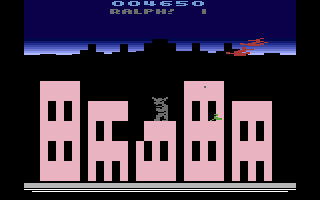 The Sega Master System and Nintendo Entertainment System ports of Rampage never really did it for me to be honest. Sure, it's great fun to eat people and smash up buidings, police cars, tanks and helicoptors. Fun for about five minutes, that is. It's funny how expectation can colour your experience of a game. Maybe I was just expecting a little more from these comparatively advanced next gen consoles, but I find the gameplay becomes a little monotonous after a while. So it's rather ironic that the fairly basic gameplay of Rampage finds an ideal home here on the Atari 2600 as one of the most advanced games ever made for the system.
The Sega Master System and Nintendo Entertainment System ports of Rampage never really did it for me to be honest. Sure, it's great fun to eat people and smash up buidings, police cars, tanks and helicoptors. Fun for about five minutes, that is. It's funny how expectation can colour your experience of a game. Maybe I was just expecting a little more from these comparatively advanced next gen consoles, but I find the gameplay becomes a little monotonous after a while. So it's rather ironic that the fairly basic gameplay of Rampage finds an ideal home here on the Atari 2600 as one of the most advanced games ever made for the system.
It truly is yet another tour de force for Activision and remarkable how much of the original Arcade game the developers have managed to squeeze into a 12k ROM. All three monster characters make an appearance, there's a two player mode so that you can mete out mayhem and destruction with a friend and a total of 85 "different" North American cities to smash up (all of which, to be honest, look largely identical). Fewer cities than in other versions of the game, but an impressive number nonetheless. The attention to detail is commendable. There's even a little news report at the start of each level!
Graphics are crude and blocky, as to be expected, but everything on screen is fairly well represented. There are plenty of things to eat, although the graphics do ocassionally make it a little difficult to tell what each item is. Some give you points and health, while others cause you harm. It's not a deep experience by any means, but like all the best Atari offerings it's a game most enjoyable in short bursts. It may be rarer and more expensive than many of the games reviewed here, but well worth picking up if you can find it (though I must admit, I may be one of the few people out there who rates this game highly).
As always, I plan to add more reviews in the future as I collect more post-1986 2600 games, but that's all for now.